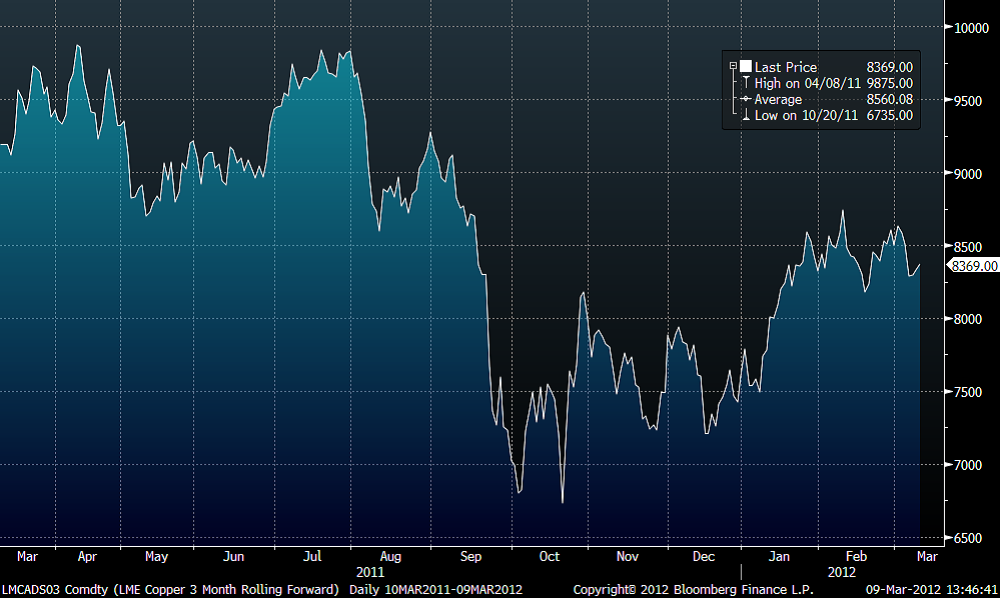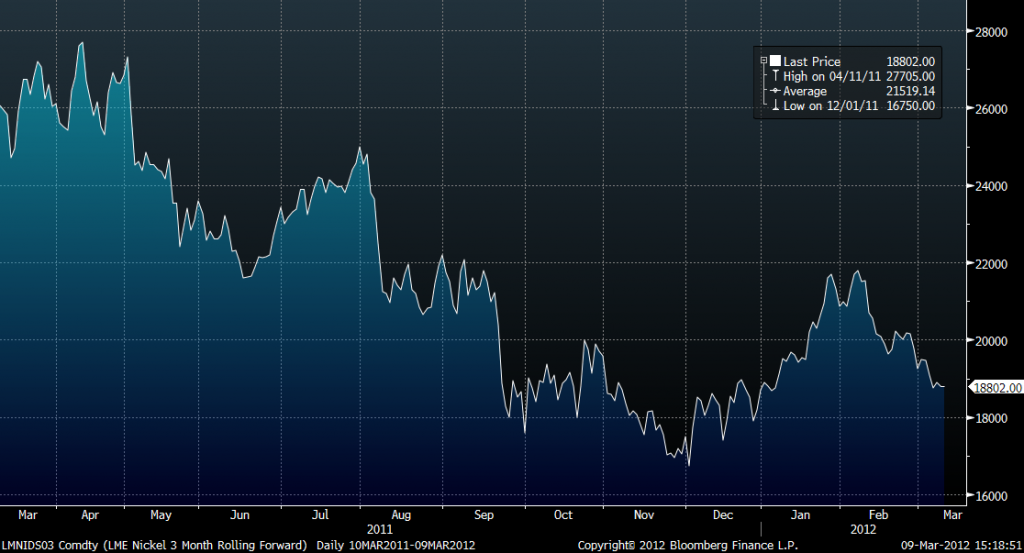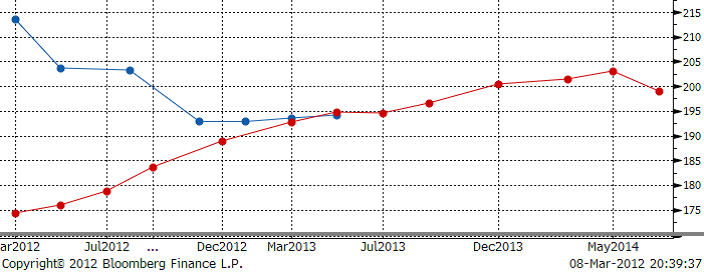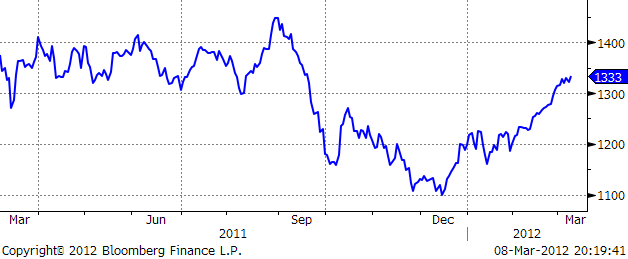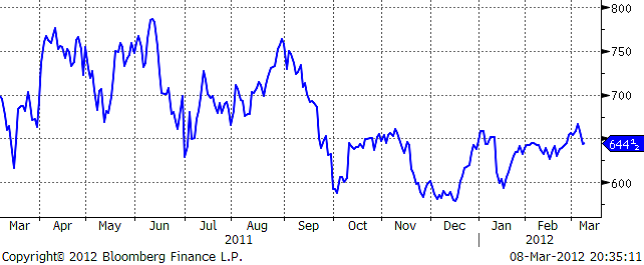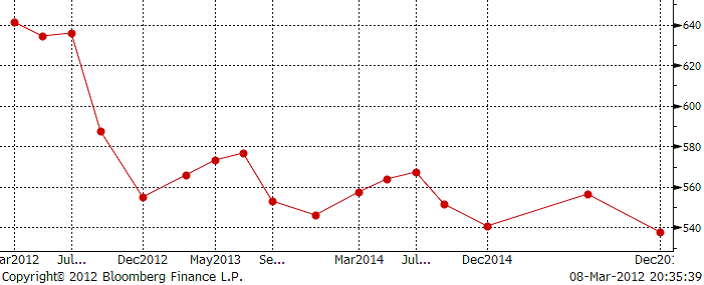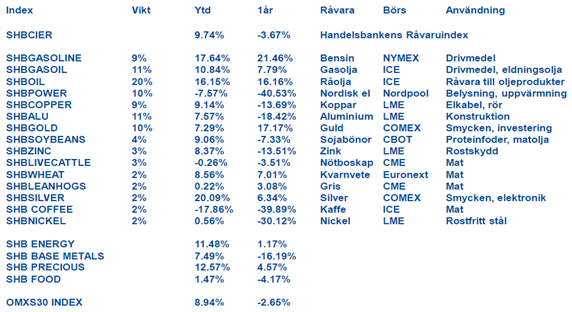Analys
SHB Råvarubrevet 9 mars 2012
 Råvaror Allmänt
Råvaror Allmänt
Våra vyer:
- Energi: Positiv
- Basmetaller: Positiv
- Ädelmetaller: Negativ
- Livsmedel: Neutral till Positiv
Centralbankerna i Europa, Japan och Storbritannien ångar på och pumpar in likviditet i det finansiella systemet samtidigt har minskat inflationstryck i många utvecklingsekonomier drivit fram räntesänkningar eller på annat vis påbörjat slutet på åtstramning. Sedan slutet av fjärde kvartalet 2011 ser vi att importen till Asien har ökat lovande och ger ett välkommet stöd till ekonomierna i väst som under sin skuldtyngda våta filt måste förlita sig till exportdriven tillväxt de kommande åren. Mest uppmärksammat har den Europeiska centralbankens likviditetsaktion varit. Cirka 300 miljarder nytryckta EUR skvalpar nu omkring och överlikvidiserar eurosystemet i än högre grad än tidigare. Kina släppte i veckan lägre inflation än väntat och det öppnar dörren för mer stimulans från råvarukonsumenten i öst som hela tiden har inflationen flåsande i nacken.
Energi (positiv)
Olja
Den ekonomiska situationen i Iran har förvärrats och iransk olja erbjuds till specialpriser. Oljeförsäljningen i Iran beräknas vara 0,3 miljoner fat per dag lägre hittills i år och förväntas falla ytterligare efter sanktioner från EU och USA.
Växande oro över handelsbegränsningar och sämre ekonomiska förhållanden, speciellt om de leder till minskad oljeproduktion i Iran. Av Irans 68 miljoner fat i reservkapacitet utnyttjas nu 20 miljoner fat. Iran försöker nu hitta nya sätt att sälja sin olja och erbjuder specialerbjudanden till allierade i Kina och Indien och levererar olja för att byta den mot guld och spannmål.
Statistik från de amerikanska oljelagren visar på stigande råoljelager med 0,8 miljoner fat (väntat 1,5 miljoner fat). Destillatlager sjönk med 1,9 miljoner fat (väntat -1,6 miljoner fat) medan bensinlager sjönk med 0,4 miljoner fat (väntat -1,6 miljoner fat).
Elmarknaden
Vi har under veckan rullat det underliggande elkontraktet i SHB Power Index till tredje kvartalet Q3 2012 på elbörsen som i skrivande stund handlas kring 34 euro, lite drygt 2 procent ned över veckan. Ett stigande bränslekomplex där bl.a. energikolet fann stöd och steg med 2.25 procent (närmaste kvartalet) och stark utveckling på den Tyska marknaden balanseras av vikande utsläppskostnader och fortsatt milt och vått väder här i Norden. Energikolet har de senaste veckorna sett ut att vara i god balans med ett överskott men det verkar nu som marknadsoron tilltagit något. Inget nämnvärt att rapportera kring den Svenska kärnkraften som går på strax över 80 procent av installerad effekt. En stor del av den nederbörd som prognostiserats för denna vecka föll bort vilket innebär att vi ligger kvar på en i stort sett oförändrad energibalans om ca 8 TWh över normalen.
Ser vi till de senaste väderprognoserna så är det fortsatt väldigt mycket varmare än normalt för de kommande 10 dagarna, ca 4 grader över, medan nederbörden ser lite mer osäker ut men ca 1TWh extra förväntas (normal nederbörd för 10 dagar så här års är ca 3.5 TWh). Det finns en sannolik utveckling mot högtryck i slutet av prognoserna men det är högst osäkert och inte tillräckligt för att driva marknaden upp. Även spotpriset är på en förhållandevis låg nivå, närmare hälften av nivån vid samma tid 2010 och 2011, vilket inte heller är tillräckligt för att få marknaden att reagera. Sammanfattar vi det hela har vi alltså en ganska neutral bild men intressant att följa utvecklingen på energikol och tyska marknaden som kan skapa en viss oro och kanske skapa lite intressant rörelser. För en bredare uppgång krävs det dock stöd från ett tydligare omslag till högtryck i vädret.
Basmetaller (positiv)
Koppar
Koppar har i likhet med de andra basmetallerna tagit stryk denna vecka. Nedgången ligger i skrivande stund på 2.25%, trots en uppgång de tre senaste dagarna. Detta är den första nedgången på veckobasis på tre veckor. De två första handelsdagarna i veckan präglades av en allmän oro kring risktillgångar och kring Grekland i synnerhet. Risksentimentet har som sagt förbättrats de senaste dagarna, efter att Greklands skuldnedskrivning har genomförts. Vi är grundpositiva till koppar, trots rapporter om kraftiga produktionsökningar i Kina (upp 9.5% från året innan). Vi tror fortsatt att ECB:s långa lån till bankerna kommer sippra ut i den reala ekonomin och på så sätt skapa press uppåt på basmetallpriserna. Ett exempel på att så redan kan vara fallet kan vi hitta i den fysiska marknaden för koppar. När koppar levereras till olika platser i världen får leverantören lägga till en premie för leveransort och försäkring. Priset för leverans till Rotterdam har gått upp från 30 USD/ton för tre månader sedan 100 USD/ton idag.
Nickel
Nickelpriset har gått ned med knappt 1 % under veckan. En faktor bakom prisnedgången var att Kina reviderade ned tillväxtmålen för sin framtida BNP-utveckling (från 8 % till 7.5 %). Landets fokus ska skiftas från volymtillväxt i ekonomin till ”tillväxt med kvalitet” (premiärminister Wen Jiabao). Trots det är vi fortsatt positiva till basmetaller, inklusive nickel. Nedrevideringen från Kina anser vi var väntad och kommer inte ge några långvariga effekter på efterfrågan. Med hjälp av ECB:s pengar kommer realekonomin i Europa ta fart och därmed ge stöd till nickelpriset framöver.
Ädelmetaller (negativ)
Förra veckans kraftiga nedgång i Handelsbankens ädelmetallindex har under den gångna veckan bromsats något. Det är fortsatt tryck nedåt på alla fyra ädelmetaller i index och den största förloraren denna vecka är silvret med en nedgång om drygt 2,5 %. En intressant observation är att de senaste två veckorna är olja och koppar helt oförändrade, medan både guld och silver fallit med 5 %.
Vår vy när det gäller just ädelmetaller är ju negativ, och det är framför allt baserat på en åsikt att guldet har gått upp för långt, drivet av riskaversion och rädsla för en fördjupad finanskris. Risken för att situationen i sydeuropa förvärras och att Grekland drar med sig Portugal, Italien och Spanien finns ju alltjämt, men den har minskat, och vi har haft väldigt lång tid på oss att vänja oss vid tanken. Detta, och det faktum att marknaden är lite ”mättad” på guldköpare gör att vi tror att nästa stora prisrörelse på guld (och därmed även silver) kommer att vara ner. Vad som kommer att orsaka det stora fallet vet vi inte, och inte heller när det inträffar. Men om Grekland skulle tvingas lämna euron, eller på annat sätt göra någonting som marknaden upplever som slutgiltigt, tror vi inte att guldet kommer stiga, mest för att det är just detta alla ”svaga” guldinnehavare hoppas på.
Magnus Strömer skrev ett ganska lång blogg-inlägg just på guldet i veckan, där alla dessa tankar utvecklas djupare, och detta går att läsa på Handelsbanken, eller på Privata Affärer. Hela resonemanget där bottnar i: Gå inte i fällan att köpa guld på dessa nivåer. Börjar det falla lite snabbare än vad som skett hittills, försök då inte fånga den fallande kniven för tidigt…
Livsmedel (neutral till positiv)
Vete (negativ)
Vetepriserna noteras ned sedan förra veckan i både Chicago och Paris, påverkat bland annat av något bättre väderlek för det amerikanska höstvetet. Regn har fallit framförallt i de mer nordliga delstaterna som North Dakota, South Dakota och Minnesota, mer regn behövs men skicket på grödan bedöms överlag vara bättre än vid samma tid förra året. Viss oro finns även att det generellt sett ganska torra vädret fortsätter, vilket kan påverka vårsådden negativt.
Ännu är omfattningen av de eventuella skadorna på det europeiska höstvetet efter tidigare kyliga väder oklart, rapporter börjar dock komma in som pekar på att oron kan ha varit något överdriven. Vetet börjar nu gå ur sin vintervila och från bland annat västra Frankrike och Tyskland uppges vetet ha klarat vintern relativt bra – den kommande tyska produktionen beräknas nu till 24,2 miljoner ton – upp 6,3 procent från förra året.
Oron börjar dock öka i södra Europa, framförallt de spanska lantbrukarna lider av torka och inga större regnmängder väntas under den närmaste tvåveckorsperioden. Vetet i Ryssland och Ukraina uppges vara väl skyddat av snö och risken för ytterligare utvintringsskador bedöms vara liten.
Ökad konkurrens på exportmarknaden när vintern släppt sitt grepp om Ryssland och dessa rapporter som än så länge pekar på små utvintringsskador på det europeiska vetet talar för att vetepriserna fortfarande har en bit kvar att falla. Väldigt god tillgång på vete globalt sett bör även leda till att marknaden reagerar mildare på eventuella produktionsbortfall. Skörden i Australien säsongen 2012/13 beräknas t.ex. falla till 25,7 miljoner ton enligt officiella uppskattningar, det från rekordhöga 29,5 miljoner ton säsongen 2011/12. Trots det beräknas exporten 2012/13 uppgå till rekordhöga 21 miljoner ton som följd av stora lager.
Sojabönor
Terminspriserna på sojabönor har fortsatt uppåt i Chicago, påverkat bland annat av fortsatt ökat köpintresse från Kina och tron om att det amerikanska jordbruksdepartementet, USDA, kommer justera ned sina förväntningar på den sydamerikanska skörden. Väldigt många analytiker i Sydamerika uppskattar skörden klart under USDA:s senaste prognos och allt tyder på att även USDA kommer justera ned sina förväntningar – frågan är mest hur mycket.
Risken att ytterligare skördeförluster uppstår framöver minskar alltmer då skörden redan kommit en bra bit på vägen, omkring hälften av den brasilianska skörden uppges vara avklarad. Få faktorer talar idag för en nedgång för sojapriserna, men en mindre korrektion nedåt vore kanske ändå inte helt förvånande efter en så lång tid av kraftig uppgång.
Majs
Terminspriserna på majs i Chicago har gått ned sedan förra veckan, påverkat av bland annat bättre väder i Sydamerika. Det råder nu torr väderlek där skörden redan startat samtidigt som regn faller i andra områden vilket gynnar mer sent utvecklad gröda – snart bör dock all gröda vara mogen så att torrt väder önskas i hela regionen. Risken att skicket på grödan förvärras ytterligare beräknas nu vara klart mindre, men marknaden förväntar sig dock att det amerikanska jordbruksdepartementet, USDA, justerar ned sin prognos för den sydamerikanska skörden likt lokala analytiker.
Amerikanska majspriser bör kunna fortsätta ned något i pris, framförallt om prognosen om en kommande rekordhög areal i USA till våren faller in. Med rådande dåliga lagersituation bör man dock inte vänta sig några större prisfall den närmaste tiden, köpintresse från bland annat Japan, Kina och Sydkorea bör också bromsa en eventuell nedgång.
Handelsbankens Råvaruindex
[box]SHB Råvarubrevet är producerat av Handelsbanken och publiceras i samarbete och med tillstånd på Råvarumarknaden.se[/box]
Ansvarsbegränsning
Detta material är producerat av Svenska Handelsbanken AB (publ) i fortsättningen kallad Handelsbanken. De som arbetar med innehållet är inte analytiker och materialet är inte oberoende investeringsanalys. Innehållet är uteslutande avsett för kunder i Sverige. Syftet är att ge en allmän information till Handelsbankens kunder och utgör inte ett personligt investeringsråd eller en personlig rekommendation. Informationen ska inte ensamt utgöra underlag för investeringsbeslut. Kunder bör inhämta råd från sina rådgivare och basera sina investeringsbeslut utifrån egen erfarenhet.
Informationen i materialet kan ändras och också avvika från de åsikter som uttrycks i oberoende investeringsanalyser från Handelsbanken. Informationen grundar sig på allmänt tillgänglig information och är hämtad från källor som bedöms som tillförlitliga, men riktigheten kan inte garanteras och informationen kan vara ofullständig eller nedkortad. Ingen del av förslaget får reproduceras eller distribueras till någon annan person utan att Handelsbanken dessförinnan lämnat sitt skriftliga medgivande. Handelsbanken ansvarar inte för att materialet används på ett sätt som strider mot förbudet mot vidarebefordran eller offentliggörs i strid med bankens regler.
Analys
Tightening fundamentals – bullish inventories from DOE

The latest weekly report from the US DOE showed a substantial drawdown across key petroleum categories, adding more upside potential to the fundamental picture.

Commercial crude inventories (excl. SPR) fell by 5.8 million barrels, bringing total inventories down to 415.1 million barrels. Now sitting 11% below the five-year seasonal norm and placed in the lowest 2015-2022 range (see picture below).
Product inventories also tightened further last week. Gasoline inventories declined by 2.1 million barrels, with reductions seen in both finished gasoline and blending components. Current gasoline levels are about 3% below the five-year average for this time of year.
Among products, the most notable move came in diesel, where inventories dropped by almost 4.1 million barrels, deepening the deficit to around 20% below seasonal norms – continuing to underscore the persistent supply tightness in diesel markets.
The only area of inventory growth was in propane/propylene, which posted a significant 5.1-million-barrel build and now stands 9% above the five-year average.
Total commercial petroleum inventories (crude plus refined products) declined by 4.2 million barrels on the week, reinforcing the overall tightening of US crude and products.


Analys
Bombs to ”ceasefire” in hours – Brent below $70

A classic case of “buy the rumor, sell the news” played out in oil markets, as Brent crude has dropped sharply – down nearly USD 10 per barrel since yesterday evening – following Iran’s retaliatory strike on a U.S. air base in Qatar. The immediate reaction was: “That was it?” The strike followed a carefully calibrated, non-escalatory playbook, avoiding direct threats to energy infrastructure or disruption of shipping through the Strait of Hormuz – thus calming worst-case fears.

After Monday morning’s sharp spike to USD 81.4 per barrel, triggered by the U.S. bombing of Iranian nuclear facilities, oil prices drifted sideways in anticipation of a potential Iranian response. That response came with advance warning and caused limited physical damage. Early this morning, both the U.S. President and Iranian state media announced a ceasefire, effectively placing a lid on the immediate conflict risk – at least for now.
As a result, Brent crude has now fallen by a total of USD 12 from Monday’s peak, currently trading around USD 69 per barrel.
Looking beyond geopolitics, the market will now shift its focus to the upcoming OPEC+ meeting in early July. Saudi Arabia’s decision to increase output earlier this year – despite falling prices – has drawn renewed attention considering recent developments. Some suggest this was a response to U.S. pressure to offset potential Iranian supply losses.
However, consensus is that the move was driven more by internal OPEC+ dynamics. After years of curbing production to support prices, Riyadh had grown frustrated with quota-busting by several members (notably Kazakhstan). With Saudi Arabia cutting up to 2 million barrels per day – roughly 2% of global supply – returns were diminishing, and the risk of losing market share was rising. The production increase is widely seen as an effort to reassert leadership and restore discipline within the group.
That said, the FT recently stated that, the Saudis remain wary of past missteps. In 2018, Riyadh ramped up output at Trump’s request ahead of Iran sanctions, only to see prices collapse when the U.S. granted broad waivers – triggering oversupply. Officials have reportedly made it clear they don’t intend to repeat that mistake.
The recent visit by President Trump to Saudi Arabia, which included agreements on AI, defense, and nuclear cooperation, suggests a broader strategic alignment. This has fueled speculation about a quiet “pump-for-politics” deal behind recent production moves.
Looking ahead, oil prices have now retraced the entire rally sparked by the June 13 Israel–Iran escalation. This retreat provides more political and policy space for both the U.S. and Saudi Arabia. Specifically, it makes it easier for Riyadh to scale back its three recent production hikes of 411,000 barrels each, potentially returning to more moderate increases of 137,000 barrels for August and September.
In short: with no major loss of Iranian supply to the market, OPEC+ – led by Saudi Arabia – no longer needs to compensate for a disruption that hasn’t materialized, especially not to please the U.S. at the cost of its own market strategy. As the Saudis themselves have signaled, they are unlikely to repeat previous mistakes.
Conclusion: With Brent now in the high USD 60s, buying oil looks fundamentally justified. The geopolitical premium has deflated, but tensions between Israel and Iran remain unresolved – and the risk of missteps and renewed escalation still lingers. In fact, even this morning, reports have emerged of renewed missile fire despite the declared “truce.” The path forward may be calmer – but it is far from stable.
Analys
A muted price reaction. Market looks relaxed, but it is still on edge waiting for what Iran will do

Brent crossed the 80-line this morning but quickly fell back assigning limited probability for Iran choosing to close the Strait of Hormuz. Brent traded in a range of USD 70.56 – 79.04/b last week as the market fluctuated between ”Iran wants a deal” and ”US is about to attack Iran”. At the end of the week though, Donald Trump managed to convince markets (and probably also Iran) that he would make a decision within two weeks. I.e. no imminent attack. Previously when when he has talked about ”making a decision within two weeks” he has often ended up doing nothing in the end. The oil market relaxed as a result and the week ended at USD 77.01/b which is just USD 6/b above the year to date average of USD 71/b.

Brent jumped to USD 81.4/b this morning, the highest since mid-January, but then quickly fell back to a current price of USD 78.2/b which is only up 1.5% versus the close on Friday. As such the market is pricing a fairly low probability that Iran will actually close the Strait of Hormuz. Probably because it will hurt Iranian oil exports as well as the global oil market.
It was however all smoke and mirrors. Deception. The US attacked Iran on Saturday. The attack involved 125 warplanes, submarines and surface warships and 14 bunker buster bombs were dropped on Iranian nuclear sites including Fordow, Natanz and Isfahan. In response the Iranian Parliament voted in support of closing the Strait of Hormuz where some 17 mb of crude and products is transported to the global market every day plus significant volumes of LNG. This is however merely an advise to the Supreme leader Ayatollah Ali Khamenei and the Supreme National Security Council which sits with the final and actual decision.
No supply of oil is lost yet. It is about the risk of Iran closing the Strait of Hormuz or not. So far not a single drop of oil supply has been lost to the global market. The price at the moment is all about the assessed risk of loss of supply. Will Iran choose to choke of the Strait of Hormuz or not? That is the big question. It would be painful for US consumers, for Donald Trump’s voter base, for the global economy but also for Iran and its population which relies on oil exports and income from selling oil out of that Strait as well. As such it is not a no-brainer choice for Iran to close the Strait for oil exports. And looking at the il price this morning it is clear that the oil market doesn’t assign a very high probability of it happening. It is however probably well within the capability of Iran to close the Strait off with rockets, mines, air-drones and possibly sea-drones. Just look at how Ukraine has been able to control and damage the Russian Black Sea fleet.
What to do about the highly enriched uranium which has gone missing? While the US and Israel can celebrate their destruction of Iranian nuclear facilities they are also scratching their heads over what to do with the lost Iranian nuclear material. Iran had 408 kg of highly enriched uranium (IAEA). Almost weapons grade. Enough for some 10 nuclear warheads. It seems to have been transported out of Fordow before the attack this weekend.
The market is still on edge. USD 80-something/b seems sensible while we wait. The oil market reaction to this weekend’s events is very muted so far. The market is still on edge awaiting what Iran will do. Because Iran will do something. But what and when? An oil price of 80-something seems like a sensible level until something do happen.
-

 Nyheter3 veckor sedan
Nyheter3 veckor sedanMahvie Minerals växlar spår – satsar fullt ut på guld
-

 Nyheter4 veckor sedan
Nyheter4 veckor sedanUppgången i oljepriset planade ut under helgen
-

 Nyheter4 veckor sedan
Nyheter4 veckor sedanLåga elpriser i sommar – men mellersta Sverige får en ökning
-

 Analys3 veckor sedan
Analys3 veckor sedanA muted price reaction. Market looks relaxed, but it is still on edge waiting for what Iran will do
-

 Nyheter3 veckor sedan
Nyheter3 veckor sedanJonas Lindvall är tillbaka med ett nytt oljebolag, Perthro, som ska börsnoteras
-

 Nyheter3 veckor sedan
Nyheter3 veckor sedanOljan, guldet och marknadens oroande tystnad
-

 Analys4 veckor sedan
Analys4 veckor sedanVery relaxed at USD 75/b. Risk barometer will likely fluctuate to higher levels with Brent into the 80ies or higher coming 2-3 weeks
-

 Nyheter3 veckor sedan
Nyheter3 veckor sedanDomstolen ger klartecken till Lappland Guldprospektering



